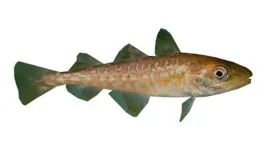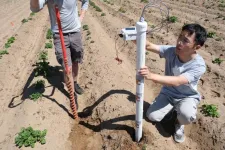(Press-News.org) During recent periods of unusually warm water in the Gulf of Alaska, young Pacific cod in near shore safe havens where they typically spend their adolescence did not experience the protective effects those areas typically provide, a new Oregon State University study found.
Instead, during marine heat waves in 2014-16 and 2019, young cod in these near shore “nurseries” around Kodiak Island in Alaska experienced significant changes in their abundance, growth rates and diet, with researchers estimating that only the largest 15-25% of the island’s cod population survived the summer. Even after the high temperatures subsided, the cod have yet to return to pre-heat wave size and diet.
The findings, published today in the journal Scientific Reports, may have broader implications for marine fish populations worldwide, as marine heat waves become longer and more frequent with climate change, the researchers said.
“These coastal habitats aren’t supporting fish in the same way that they used to as a result of marine heat waves,” said lead author Hillary Thalmann, a graduate student in OSU’s Department of Fisheries, Wildlife and Conservation Sciences. “That’s a novel finding, because we don’t always look at the nurseries as a place where size-selective mortality could be occurring rapidly.”
Pacific cod, a popular choice for fish and chips, is the second-largest commercial groundfish fishery off the coast of Alaska. The 2022 commercial harvest totaled 403 million pounds and was valued at $225 million, according to NOAA Fisheries. Cod also has a long history in Alaskan culture and is important to Indigenous communities in the region.
The nurseries are shallow areas along shorelines with lots of aquatic vegetation, including eelgrass, algae and kelp, which attract lots of food for the fish and provide hiding places where they can avoid predators. Typically, they are considered safe havens for small Pacific cod — areas where the fish go at around 3 months old to eat and grow as much as they can during their first summer and fall.
But during the two recent marine heat waves in the Gulf of Alaska, water temperatures were recorded at 58 degrees Fahrenheit, almost 6 degrees above normal. Together, the two heat waves are considered the most extreme warming events on record in the Northeast Pacific Ocean, and the effects on the cod population were so severe that the fishery was closed in 2020 and a federal disaster was declared in 2022.
Previous OSU research has found that the higher temperatures triggered earlier reproduction and high mortality among young Pacific cod. The new study focuses on the physiological disruptions the young cod experienced while occupying the coastal nurseries.
Researchers used juvenile Pacific cod collected by the NOAA Alaska Fisheries Science Center Fisheries Behavioral Ecology program from 16 sites around Kodiak Island in mid-July and late August for the years 2006-2019. This sampling was part of routine population monitoring for the cod fishery.
For the July sample, researchers looked at the fishes’ otoliths, tiny bony structures that chronicle a fish’s growth similar to the rings of trees. Measuring the otoliths allowed researchers to calculate the fishes’ precise rate of growth up to the July sampling date, and then calculate their projected size based on maintaining that same growth rate into August.
However, when they looked at the August sample, the fish were 30% bigger than the size predicted by the established growth rate, and there were almost no small fish present in the sample. The only way researchers were able to account for the size of the fish in August was to remove all the small fish from the July sample and leave just the largest 15-25% of fish following the projected growth rate trajectory.
“If we removed the little guys and grew the big guys — the top 15-25% — through to August based on the growth rates we saw earlier in the summer, then we got the size range that we see in those heat wave years,” Thalmann said. “It’s important to show that with heat events like this, size-selective mortality can continue in the cod population beyond just their early life in the open water,” where the larvae spend their first three months.
Size-selective mortality is the phenomenon of survival being determined by an organism’s size; here, only the biggest fish appear to have survived.
“We saw these differences in size in the nursery, and we tried to explain them with growth rates and tried to explain them with diet, but we couldn’t explain it all,” Thalmann said. “There was something out there, probably size-selective mortality, that was the major driver for what we were seeing.”
Moving forward, researchers say changing ocean conditions may mean that Pacific cod have to move further north to find optimal growth environments, or there may be a shift toward bigger cod being the only ones to survive and contribute genetic information to subsequent generations.
“If the marine heat waves continue, there will probably be some changes in both the distribution and the quality of these populations,” Thalmann said. “I don’t think it’s the end of fish and chips, but I do think it’s a cautionary tale for climate change and the shifting dynamics of fisheries in warm temperatures.”
Co-authors on the study were Zoe Almeida, Kaitlyn Osborne, Kaylee Marshall and Jessica Miller at OSU and Benjamin Laurel at the NOAA Alaska Fisheries Science Center in Newport, Oregon.
END
Pacific cod can’t rely on coastal safe havens for protection during marine heat waves, OSU study finds
2024-06-27
ELSE PRESS RELEASES FROM THIS DATE:
Bird flu stays stable on milking equipment for at least one hour
2024-06-27
Bird flu, or H5N1 virus, in unpasteurized milk is stable on metal and rubber components of commercial milking equipment for at least one hour, increasing its potential to infect people and other animals, report researchers from the University of Pittsburgh School of Medicine and Emory University in Emerging Infectious Diseases.
The study underscores the heightened risk of bird flu exposure for dairy farm workers and signals the need for wider adoption of personal protective equipment, including face shields, masks and eye protection.
“Dairy cows have to be milked even if they are sick, and it has not been clear for how long the virus contained in residual milk from the ...
Printed sensors in soil could help farmers improve crop yields and save money
2024-06-27
MADISON — University of Wisconsin–Madison engineers have developed low-cost sensors that allow for real-time, continuous monitoring of nitrate in soil types that are common in Wisconsin. These printed electrochemical sensors could enable farmers to make better informed nutrient management decisions and reap economic benefits.
“Our sensors could give farmers a greater understanding of the nutrient profile of their soil and how much nitrate is available for the plants, helping them to make more precise decisions on how much fertilizer they really need,” says Joseph Andrews, an assistant professor of mechanical ...
Neighborhood opportunities influence infant development and cognition
2024-06-27
Growing up in neighborhoods with more educational and socioeconomic opportunities has a positive impact on infants’ brain activity, according to new research from Boston Medical Center (BMC). The study, published in The Journal of Developmental & Behavioral Pediatrics, suggests that enhancing neighborhood opportunities, particularly in education, can be a promising approach to promoting early childhood development.
A team of early childhood researchers examined how neighborhood opportunity – the socioeconomic, educational, health, and ...
New twists on tornadoes: Earth scientist studies why U.S. has so many tornadoes
2024-06-27
WEST LAFAYETTE, Ind. — Across the Midwest during the warmer months, studying the sky for signs of storms and tornadoes becomes one of the most popular pastimes.
Dan Chavas, an associate professor in the Department of Earth, Atmospheric, and Planetary Sciences at Purdue University’s College of Science, takes it further: All day every day, he studies what makes tornadoes tick. Working at the intersection of climate science and meteorology, he looks at the big picture of what causes severe storms and tornadoes — and what dictates where ...
Children’s Hospital of Philadelphia researchers find elementary age children experience more concussions during activities unrelated to sports
2024-06-27
Philadelphia, June 27, 2024 – Researchers from Children’s Hospital of Philadelphia (CHOP) found that young children between the ages of 5 and 12 were more likely to experience a concussion from recreation and other non-sport activities, yet those injuries were not seen by specialists until days later compared with sports-related concussions in the same age group.
This study suggests concussion research is needed for children outside of sports and that providing more resources and education ...
Ultrasounds may not find this cancer in Black women
2024-06-27
A common algorithm to check for endometrial cancer is not reliable for Black women, according to a new study published today in JAMA Oncology.
In Black patients with concerning symptoms, a tissue biopsy is strongly recommended to rule out endometrial cancer instead of using transvaginal ultrasound, the report concluded.
Endometrial cancer is the most common type of gynecological cancer in the United States. It is one of the few types of cancer now on the rise, especially among Black women, who are more likely to be diagnosed at later stages of the disease. This cancer can cause symptoms such as abnormal vaginal ...
Urban green and blue spaces are linked to less coronary artery calcification
2024-06-27
· Black participants with greater access to green spaces had up to 35% lower odds of calcification
· Black participants living near a river had 32% lower odds of calcification
· Coronary artery calcification is an early sign of cardiovascular disease
CHICAGO --- Being near and having more exposure to urban green space and blue (water) space is linked to lower odds of having coronary artery calcification in middle age, which is an early marker of cardiovascular disease.
The associations were more pronounced among Black individuals and those living in neighborhoods ...
US efforts to collect LGBTQ+ data among Medicaid patients is a ‘foundational step towards health equity'
2024-06-27
Compared to straight and cisgender individuals, sexual and gender minority adults in the US are more likely to face barriers paying for or accessing adequate health insurance and healthcare, but few states collect sexual and gender identity (SOGI) information to better understand the health challenges and needs of this population. To close this knowledge gap, the Centers for Medicare & Medicaid Services (CMS) added three optional SOGI questions to its model application, with guidance for states that choose to incorporate the questions into their Medicaid and Child Health Insurance ...
Wolves reintroduced to Isle Royale temporarily affect other carnivores, humans have influence as well
2024-06-27
MADISON–In a rare opportunity to study carnivores before and after wolves were reintroduced to their ranges, researchers from the University of Wisconsin–Madison found that the effects of wolves on Isle Royale have been only temporary. And even in the least-visited national park, humans had a more significant impact on carnivores’ lives.
The paper, published recently in Frontiers in Ecology and the Environment, uses DNA from foxes and martens’ scat and hair to understand where these animals were and what they ...
Common blood pressure drug may make leukemia more responsive to chemotherapy while protecting heart
2024-06-27
COLUMBIA, Mo. ― Researchers from the University of Missouri School of Medicine found that a targeted gene therapy may make acute myeloid leukemia (AML) more sensitive to chemotherapy, while also protecting the heart against toxicity often caused by cancer treatments.
Acute myeloid leukemia is the most common type of leukemia in adults and the resulting chemotherapy treatment can put patients at an increased risk for cardiac damage. Associate Professor of Medicine Dr. Xunlei Kang and PhD students Yi Pan and Chen Wang led a study looking at similarities between leukemia and cardiovascular disease. They found a shared target -- AGTR1, ...



